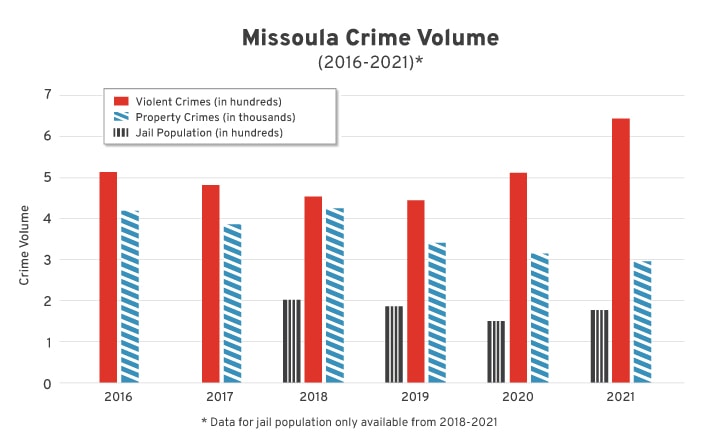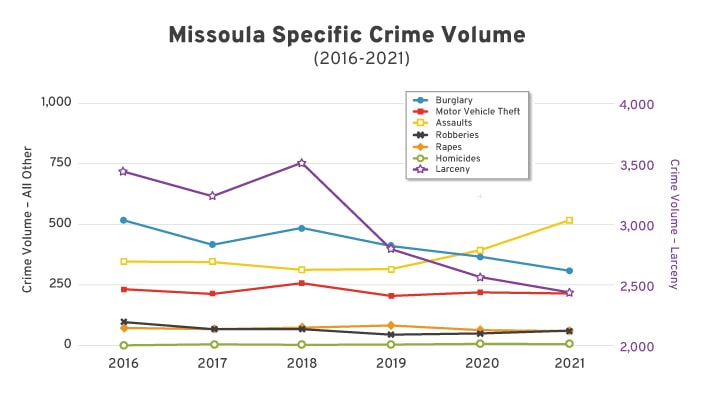Criminal Justice Reform Efforts and Rise in Crime: Spotlight on Missoula, Mont.
This is the sixth in a series of posts on the subject. Scroll to the end to see the most recent posts in the series.
Introduction
The nation has been captivated by reports of rising crime and the wave of criminal justice reform. Some news outlets and elected officials claim a correlation between the two, but this is perhaps a hasty assessment. In order to better understand how criminal justice reform efforts could be affecting increases in crime, we will be digging into the data, history and current criminal justice reform efforts of six Safety and Justice Challenge sites across the United States. Readers can learn about unique criminal justice reform initiatives in these communities as well as whether the implementation of these efforts (or lack thereof) could be associated with an increase or decrease in crime. To learn more about this series, you can access the introduction here.
Location Information
Missoula County, Mont., home to the “Garden City,” is known for its outdoor recreation and beauty. Approximately 120,000 individuals reside in Missoula County, with an additional 10,000 university students. Two law enforcement agencies cover the 2593 square miles of Missoula, making Missoula one of the smaller jurisdictions to join the Safety and Justice Challenge.
Crime Statistics
From 2016 to 2021, property crimes in Missoula have declined. Conversely, violent crime declined for four years and then significantly increased in 2020 and 2021. Other than a significant decline and rebound during the COVID-19 pandemic, the Missoula jail population has stayed fairly consistent with only a slight decline since 2018. The graph below reflects these trends.

Individual crime rates have not followed consistent trends. While murders increased in the last two years, rapes—after fluctuating up and down—decreased over the last two years. Robberies and assaults dropped from 2016 only to increase again in 2021, with assaults significantly breaking their six-year high. Motor vehicle thefts remained lower than their six-year high, but have become fairly stagnant in the last three years. Only burglaries and other types of larceny saw a fairly consistent and significant reduction over the six-year period. These individual crime trends, compiled from the Montana Board of Crime Control Statistical Analysis Center, are reflected in the graph below.

Criminal Justice Reform Efforts
Missoula has highlighted criminal justice reforms over the last several years. The county has implemented criminal justice reform efforts such as Montana’s first prosecutorial adult diversion program: in 2019, Calibrate (2019) established a peer support specialist through the public defender’s office to assist Indigenous defendants in navigating the criminal justice system. The county also created the Missoula City-County Jail Diversion Master Plan in 2016. Missoula has taken several other criminal justice reform initiatives; three that help reduce jail populations are highlighted below.
Pre-arrest Diversion
- In the fall of 2020, Missoula launched a Mobile Support Team (MST) to respond to low-risk behavioral health 911 calls, which diverted individuals from jail and the hospital. This partnership between the local fire department and the Partnership Health Center reduces the time and resources needed from law enforcement and emergency departments. The response team consists of a licensed mental health clinician and an emergency medical technician. A case facilitator then provides follow-up services and support for the individuals contacted by the response team. The MST also works closely with the law enforcement’s Crisis Intervention Team. From the MST’s launch on 16, 2020 to June 30, 2021, the team responded to 537 calls resulting in 169 individuals diverted from the hospital, 13 individuals diverted from jail and an overall 68 percent of the contacted individuals remaining in the community.
Pretrial Release
- In 2017, Montana implemented a pretrial public safety assessment (PSA) to be used in five pilot counties, Missoula County being one pilot site that began use of the PSA in 2019. The PSA uses nine factors to help decide pretrial release and bond conditions that would promote court appearance and public safety. The goal of the PSA was to reserve incarceration for individuals who posed the greatest risk to fail to appear in court or reoffend. Public officials believed that by keeping individuals out of the jail, the county could protect someone’s presumption of innocence while also saving taxpayer money. The risk assessment gives a score of 1-3, with a 3 recommending the most conditions for release, which can include electronic home monitoring, supervision check-ins and monetary conditions. Research shows that pretrial public safety assessments can be effective in determining pretrial outcomes. Similarly, some studies show that court-ordered conditions for release—such as supervision or drug testing—can also increase an individual’s success on pretrial release. Unfortunately, even with these tools in place, Missoula continues to struggle with court appearances and, in some cases, released individuals reoffending. From Jan. 1, 2019 to Dec. 31, 2021, approximately 81 percent of individuals were released pretrial. Of those released, 26 percent failed to appear for court and 15 percent committed a new felony while on release.
- In late 2019, Missoula worked to reduce the time between a defendant’s initial appearance and arraignment to try and reduce jail admissions and average length of stay for people charged with non-violent crimes. While these pretrial strategies had positive initial results—such as reducing misdemeanor jail admissions by over 60 percent and the average daily jail population for misdemeanors by over 50 percent—both matrices have been increasing in the last several years.
Criminal Mediation
- While the Montana legislature passed legislation for prosecutors to use criminal mediation in 2009, it was not until 2014 when Missoula became the first county to use it. Criminal mediation uses elements of restorative justice by bringing the offender, the victim and the attorneys together to come to a resolution in a criminal case. By allowing victims to confront the offender with questions, relay how they have been affected and help develop a restitution plan, criminal mediation can hold offenders accountable while also better supporting the victims’ needs. Criminal mediation can also save significant money for the criminal justice system by avoiding costly trials.
Missoula has been a leader in criminal justice reforms in Montana. Missoula has targeted diverting individuals charged with nonviolent offenses to alleviate overcrowded jails and save taxpayer dollars while also working toward reducing recidivism and upholding public safety. Research shows that, if implemented properly, reform efforts similar to those implemented in Missoula free up valuable resources without compromising public safety. In the case of Missoula, these reforms support the goals that the county has set forth.
Conclusion
Evaluation of the collected data shows it is unlikely that criminal justice reform efforts in Missoula County have contributed to a rise in crime.
Missoula’s criminal justice reform efforts are aimed at low-level, nonviolent offenders. While property crimes dipped and then increased from 2016-2018, the steady decline in cases from 2018 through 2021 correlates with the implementation of reforms in Missoula. Therefore, it is concluded that the reforms in Missoula could not have caused an increase in these crimes.
Rapes in Missoula decreased in 2017 after the implementation of criminal mediation, but then increased for the following three years, during which time the PSA was implemented. Rapes then decreased for the two years following the implementation of Calibrate and the MST. Overall, rapes continue to be below their six-year high. For that reason, it is concluded that reform efforts also did not cause an increase in this crime.
Missoula saw a decline in robberies and assaults since the implementation of criminal mediation and the PSA. However, Missoula did show an incline after the implementation of the MST and Calibrate. Similarly, after rising in 2017—which was not until several years after the implementation of criminal mediation—murders fell during the implementation of pretrial release reforms, but then increased after the start of MST and Calibrate. Notably, however, Missoula’s murder rates are minimal compared to other jurisdictions; a decrease or increase in this trend is based on 1 to 3 offenses per year. Further, the number of participants in these programs is rather low and Missoula does not use the MST or Calibrate for violent offenders. In fact, despite low property crime rates and development of diversion programs, the use of the jail in Missoula remains consistent.
Regardless, the correlation of timing needs to be further explored. It would be beneficial for Missoula County to analyze whether participants in Calibrate or the MST were later accused of these violent offenses. If a correlation exists and an increasing trend persists, then it could mean these reforms are compromising public safety. However, the increase in assault and murders following the COVID-19 pandemic is aligned with national trends that have been aligned with an increase in mental health crises and gun sales seen in Montana even prior to 2020. While Missoula officials should monitor and continually evaluate murder, robbery and assault trends, it is unlikely MST and Calibrate diversion efforts focused on low-level offenders caused an increase in any of these violent crimes.
This post will be updated with links to each part in the series.
- Criminal Justice Reform Efforts and Rise in Crime: Introduction
- Criminal Justice Reform Efforts and Rise in Crime: Spotlight on Broward County, Fla.
- Criminal Justice Reform Efforts and Rise in Crime: Spotlight on Clark County, Nev.
- Criminal Justice Reform Efforts and Rise in Crime: Spotlight on City of St. Louis, Mo.
- Criminal Justice Reform Efforts and Rise in Crime: Spotlight on Allegheny County, Pa.
- Criminal Justice Reform Efforts and Rise in Crime: Spotlight on Baton Rouge, La.
- Criminal Justice Reform Efforts and Rise in Crime: Spotlight on Missoula, Mont.
- Criminal Justice Reform Efforts and Rise in Crime: Conclusion







